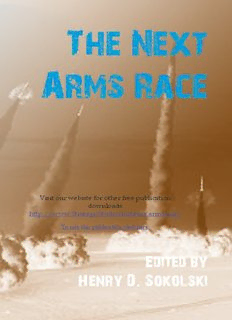
The Next Arms Race - Strategic Studies Institute - U.S. Army PDF
Preview The Next Arms Race - Strategic Studies Institute - U.S. Army
T h e N e x t A r m s R a c e U.S. ARMY WAR COLLEGE Visit our website for other free publication downloads http://www.StrategicStudiesInstitute.army.mil/ To rate this publication click here. HE ed nit re yd D b . y S o k o l s k i This Publication SSI Website USAWC Website Strategic Studies Institute Book THE NEXT ARMS RACE Henry D. Sokolski Editor July 2012 The views expressed in this report are those of the authors and do not necessarily reflect the official policy or position of the De- partment of the Army, the Department of Defense, or the U.S. Government. Authors of Strategic Studies Institute (SSI) publica- tions enjoy full academic freedom, provided they do not disclose classified information, jeopardize operations security, or mis- represent official U.S. policy. Such academic freedom empow- ers them to offer new and sometimes controversial perspectives in the interest of furthering debate on key issues. This report is cleared for public release; distribution is unlimited. ***** This publication is subject to Title 17, United States Code, Sec- tions 101 and 105. It is in the public domain and may not be copy- righted. ***** Comments pertaining to this report are invited and should be forwarded to: Director, Strategic Studies Institute, U.S. Army War College, 47 Ashburn Drive, Carlisle, PA 17013-5046. ***** All Strategic Studies Institute (SSI) publications may be downloaded free of charge from the SSI website. Hard copies of this report may also be obtained free of charge while supplies last by placing an order on the SSI website. SSI publications may be quoted or reprinted in part or in full with permission and ap- propriate credit given to the U.S. Army Strategic Studies Insti- tute, U.S. Army War College, Carlisle Barracks, PA. Contact SSI by visiting our website at the following address: www.Strategic StudiesInstitute.army.mil. ***** The Strategic Studies Institute publishes a monthly e-mail newsletter to update the national security community on the re- search of our analysts, recent and forthcoming publications, and upcoming conferences sponsored by the Institute. Each newslet- ter also provides a strategic commentary by one of our research analysts. If you are interested in receiving this newsletter, please subscribe on the SSI website at www.StrategicStudiesInstitute. army.mil/newsletter/. ISBN 1-58487-534-8 ii CONTENTS Foreword ....................................................................vii 1. Overview .................................................................1 Henry D. Sokolski PART I: ASIA 2. Asian Drivers of Russia’s Nuclear Force Posture .........................................................45 Jacob W. Kipp 3. China’s Strategic Forces in the 21st Century: The People’s Liberation Army’s Changing Nuclear Doctrine and Force Posture ..................83 Michael Mazza and Dan Blumenthal 4. P lutonium, Proliferation and Radioactive-waste Politics in East Asia ........... 111 Frank von Hippel 5. C hina and the Emerging Strategic Competition in Aerospace Power .....................141 Mark Stokes and Ian Easton PART II: MIDDLE EAST 6. The Middle East’s Nuclear Future ................... 179 Richard L. Russell 7. Alternative Proliferation Futures for North Africa................................................... 205 Bruno Tertrais iii CONTENTS 8. C asting a Blind Eye: Kissinger and Nixon Finesse Israel’s Bomb..............................239 Victor Gilinsky PART III: SOUTH ASIA 9. N uclear Weapons Stability or Anarchy in the 21st Century: China, India, and Pakistan ........................................................261 Thomas W. Graham 10. Nuclear Missile-Related Risks in South Asia.......................................................305 R. N. Ganesh 11. Prospects for Indian and Pakistani Arms Control .....................................................357 Feroz Hassan Khan PART IV: POST-COLD WAR MILITARY SCIENCE AND ARMS CONTROL 12. T o What Extent Can Precision Conventional Technologies Substitute for Nuclear Weapons? ...................................... 387 Stephen J. Lukasik 13. Missiles for Peace .............................................. 413 Henry D. Sokolski 14. Missile Defense and Arms Control.................. 425 Jeff Kueter iv CONTENTS 15. A Hardheaded Guide to Nuclear Controls............................................................... 477 Henry D. Sokolski About the Contributors........................................... 513 v FOREWORD This volume is the 15th in a series of edited vol- umes of contracted research the Nonproliferation Pol- icy Education Center (NPEC) has published in coop- eration with the Strategic Studies Institute (SSI) of the U.S. Army War College. The volume showcases stud- ies that were done over the past 3 years on what the next set of strategic nuclear competitions might look like. Funding for this project came from the Carnegie Corporation of New York and the U.S. Department of Defense. Much of the work to format the book was done by NPEC’s research associate, Kate Harrison. Without her help and that of Dr. James Pierce and Rita Rummel of SSI, this book would not have been pos- sible. Finally, thanks are due to the project’s authors and reviewers who contributed their time and ideas. HENRY D. SOKOLSKI Executive Director The Nonproliferation Policy Education Center vii CHAPTER 1 OVERVIEW Henry D. Sokolski With most of the world’s advanced economies now stuck in recession; Western support for defense cuts and nuclear disarmament increasing; and a major emerging Asian power at odds with its neighbors and the United States; it is tempting to think our times are about to rhyme with a decade of similar woes—the disorderly 1930s.1 Might we again be drifting toward some new form of mortal national combat? Or, will our future more likely ape the near-half-century that defined the Cold War—a period in which tensions between competing states ebbed and flowed but peace mostly prevailed by dint of nuclear mutual fear and loathing? The short answer is, nobody knows. This much, however, is clear: The strategic military competitions of the next 2 decades will be unlike any the world has yet seen. Assuming U.S., Chinese, Russian, Israeli, Indian, French, British, and Pakistani strategic forces continue to be modernized and America and Russia continue to reduce their strategic nuclear deploy- ments, the next arms race will be run by a much larger number of contestants—with highly destructive stra- tegic capabilities far more closely matched and capable of being quickly enlarged than in any other previous period in history. 1
Description: